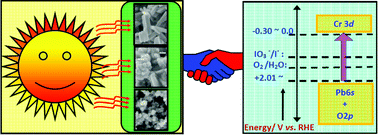Developing stable semiconducting oxides that are active in the visible region for photocatalytic reactions is a major technological challenge. Herein, we report a facile co-precipitation based synthesis of PbCrO4 nanostructures with the aim to study their hitherto unreported hydrogen production potential. It has been observed that monoclinic PbCrO4 nanorods have been generated using a simple co-precipitation method in the presence of water and methanol as solvents while spherical nanostructures are produced using an ultrasonication assisted co-precipitation method. The nanorods synthesized by the aqueous co-precipitation method have yielded the highest rate of hydrogen production (3214 μmol h−1 0.5 g−1) by splitting hydrogen sulfide (H2S) gas.

